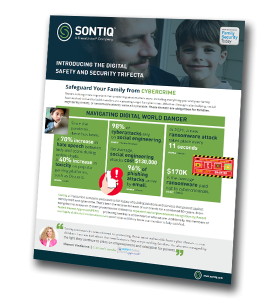Summary:
Cyberbullying, simply put, is bullying through digital channels such as social media, texts and gaming. It occurs when one individual harasses, intimidates or threatens another person via computer, telephone or other portable device. These bullies take advantage of the anonymity of the internet and digital channels to inflict their bad behavior on others.
Although often viewed as a crime against children, cyberbullying affects people of all ages. Often, cyberbullying against adults is called other names, including stalking and online harassment. Pew Research found that 41% of U.S. adults have experienced online harassment.
Cyberbullying affects people’s reputation, mental health and financial well-being. It’s not just a single victim’s issue. The time and effort necessary to shut down bullying attacks can severely impact employees’ productivity, making it a business issue.
To effectively deal with cyberbullying, you should know how to detect it and the steps you can take to help stop it.
The Recent Growth Of Cyberbullying
Cyberbullying affects a large number of children in the U.S. The Centers for Disease Control and Prevention (CDC) notes that 30% of high school students and 33% of middle schoolers have been cyberbullied during the previous 12 months. As children get older, they are more likely to experience cyberbullying — between the ages of 10 and 18, a child’s likelihood of being cyberbullied increases by 2% every two years.
Observers caution that social media is often a major factor in cyberbullying. Among the different platforms, the social media sites with the highest rates of cyberbullying are YouTube (79%), Snapchat (69%), TikTok (64%) and Facebook (49%).
Cyberbullying can take many forms. Stopbullying.gov lists the common tactics as:
- Posting comments or rumors about someone online that are mean, hurtful or embarrassing.
- Threatening to hurt someone or telling them to kill themselves.
- Posting a mean or hurtful picture or video.
- Pretending to be someone else online to solicit or post personal or false information about someone else.
- Posting mean or hateful names, comments, or content about any race, religion, ethnicity or other personal characteristics online
- Creating a mean or hurtful webpage about someone.
- Doxing, an abbreviated form of the word “documents,” is a form of online harassment used to exact revenge by threatening or destroying the privacy of individuals. This involves making the victim’s personal information public, including home and work addresses, Social Security, credit card and phone numbers, links to social media accounts and other private data.
How to Detect Cyberbullying
The shame attached to cyberbullying often allows incidents to go undetected, and, unlike physical bullying, the mental bruises are harder to notice. In the 5th Anniversary edition of Protecting What Matters Most, Sharon Vinderine, CEO and Founder of Parent Tested Parent Approved (PTPA), explained the top ways to detect if someone you care about is being cyberbullied.
- Decreasing device use and hiding screens when others come around.
- Avoiding discussions about what’s going on at school or work.
- Becoming emotionally upset during or after using devices.
- Declining grades.
- Withdrawing from family and friends and losing interest in activities they used to enjoy.
- Showing signs of depression and anxiety or acting out.
- Changing moods after receiving messages.
- Displaying sudden changes in sleep habits
What to do when cyberbullying occurs
The impact of cyberbullying can be severe, threatening both the mental and financial health of victims and their families. More than 60% of students who experience cyberbullying stated it deeply affected their ability to learn and feel safe at school. Families face the costly and time-consuming challenges of getting counseling, removing online content, hiring legal representation and even relocating.
Victims can take proactive steps to end the bullying. If you think someone you care about is being cyberbullied, you can help them respond effectively and get the help they need:
- Give this person a safe, supportive outlet to talk and explain what’s happening, how it started and who’s involved.
- Parents and guardians can get online family protection tools with parental controls, letting them block specific websites, enforce online time limits and monitor online websites, as well as monitoring online conversations for certain words.
- Keep a record of what’s happening, including screenshots of harmful posts and content. Bullying is typically a repeated behavior, and these records are documented proof.
- Block the cyberbully, but do NOT respond to or forward the cyberbullying communications.
- Report the cyberbullying:
- Online platforms: Most social media platforms and ISPs have clear policies and terms of service regarding cyberbullying.
- Schools or organizations: Most schools, employers, and organizations have clear policies against cyberbullying.
- Police: If the person being bullied is receiving threats or there’s a potentially related crime, report it to the police.
- Get professional support if needed, including a mental health professional or guidance counselor.
- Contact the HR department at your family’s employer. Many employers offer benefits that can help a victim and their family receive assistance, including counseling, paid time off and legal aid.
Cyberbullying: Detection, Response, and Resolution
Sontiq’s Digital Safety and Security Features for families specifically address cyberbullying in addition to social engineering and ransomware attacks. The industry-first bundled offering is part of the identity theft and cyberthreat protection now available in Sontiq’s Identity Theft Protection plans for families. The cyberbullying reimbursement portion of the bundle helps families with:
- Obtaining the services of a specialist to remove online content
- Seeking counseling and rehabilitation services
- Acquiring the services of a digital forensic service provider
- Relocating to a new educational facility
- Finding legal resources
- Receiving reimbursement for up to $25,000
Protecting families is at the heart of who we are. Sontiq continues to deliver on our commitment to helping families protect themselves from ever-evolving cyber threats. You can find more information on the service in our Digital Safety and Security Features datasheet.
View Our Digital Safety & Security Features Datasheet.

Cyberbullying Resources
Cyberbullying can be a humiliating experience that impacts the lives of the victim and family, including school, social, financial and work. Knowledge empowers you to help yourself, your family and others you care about who may be victims of cyberbullying. Here are a few places to get more information:




